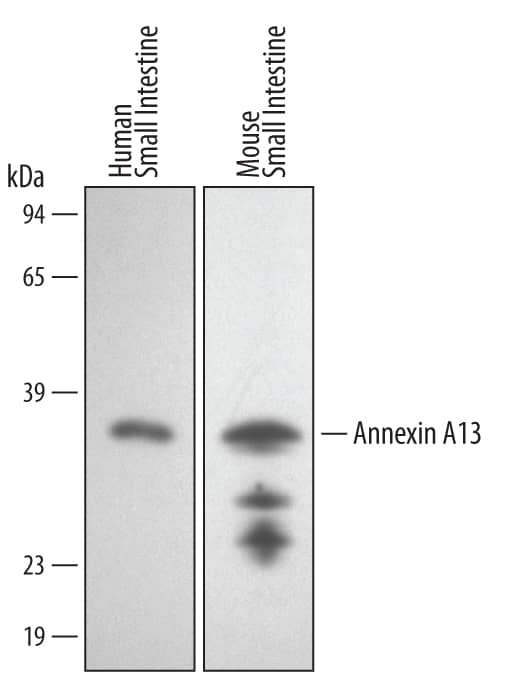Human/Mouse Annexin A13 Antibody
R&D Systems, part of Bio-Techne | Catalog # AF4149

Key Product Details
Species Reactivity
Validated:
Cited:
Applications
Validated:
Cited:
Label
Antibody Source
Product Specifications
Immunogen
Met1-His316
Accession # P27216
Specificity
Clonality
Host
Isotype
Scientific Data Images for Human/Mouse Annexin A13 Antibody
Detection of Human/Mouse Annexin A13 by Western Blot.
Western blot shows lysates of human and mouse small intestine tissue. PVDF membrane was probed with 1 µg/mL of Human/Mouse Annexin A13 Antigen Affinity-purified Polyclonal Antibody (Catalog # AF4149) followed by HRP-conjugated Anti-Goat IgG Secondary Antibody (Catalog # HAF017). A specific band was detected for Annexin A13 at approximately 36 kDa (as indicated). This experiment was conducted under reducing conditions and using Immunoblot Buffer Group 1.Applications for Human/Mouse Annexin A13 Antibody
Western Blot
Sample: Human and mouse small intestine tissue
Formulation, Preparation, and Storage
Purification
Reconstitution
Formulation
Shipping
Stability & Storage
- 12 months from date of receipt, -20 to -70 °C as supplied.
- 1 month, 2 to 8 °C under sterile conditions after reconstitution.
- 6 months, -20 to -70 °C under sterile conditions after reconstitution.
Background: Annexin A13
Annexin A13 (ANXA13), also known as Annexin XIII and Intestine-Specific Annexin, is a member of the Annexin protein family. Two isoforms have been identified resulting from alternate splicing. Isoform A consists of 316 amino acids and has a predicted molecular weight of 36 kDa whereas isoform B is composed of 357 amino acids and has a predicted molecular weight of 40 kDa. Annexins are a family of Calcium-dependent phospholipid-binding proteins that are preferentially located on the cytosolic face of the plasma membrane. The Annexin’s have a molecular weight of approximately 35 to 40 kDa and consist of a unique amino terminal domain followed by a homologous C-terminal core domain containing the calcium-dependent phospholipid-binding sites. The C terminal domain is comprised of four 60‑70 amino acid repeats, known as annexin repeats or an endonexin fold (Annexin A6 contains 8 annexin repeats). The four annexin repeats form a highly alpha-helical, tightly packed disc known as the annexin domain, which binds to phospholipids in the membrane in a calcium-dependent manner. Members of the annexin family play a role in cytoskeletal interactions, phospholipase inhibition, regulation of cellular growth, and intracellular signal transduction pathways. The specific function of Annexin A13 has not been determined but it is associated with the plasma membrane of undifferentiated, proliferating endothelial cells and differentiated villus enterocytes.
Alternate Names
Gene Symbol
UniProt
Additional Annexin A13 Products
Product Documents for Human/Mouse Annexin A13 Antibody
Product Specific Notices for Human/Mouse Annexin A13 Antibody
For research use only
